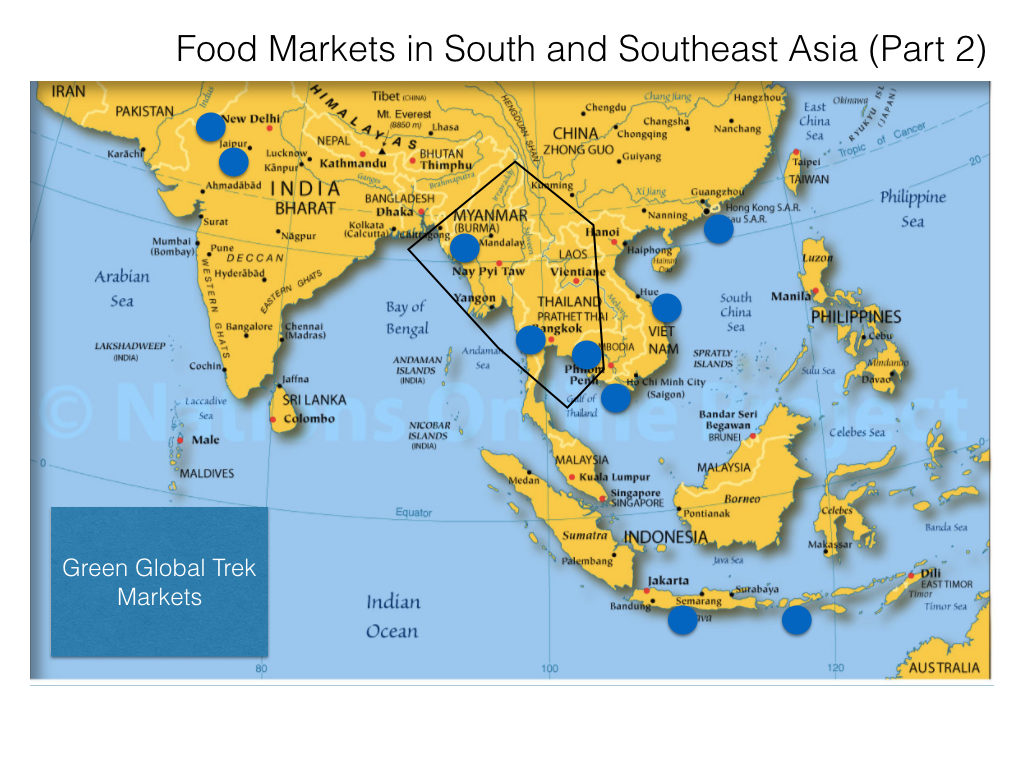
Market in Koh Lanta, Thailand
It seems counter-intuitive to introduce markets in Thailand by featuring a market in the Muslim South. After all, most would equate Thailand with Buddhism. And yet, there is a Muslim minority with a vibrant market in Koh Lanta, Thailand
But first, some visual context for what’s in the nearby vicinity… We were in Koh Lanta during a military coup in Bangkok. A military curfew was imposed and all the headlines in the newspapers reflected this momentous political development. But on the island of Koh Lanta the military coup seemed like a very distant event.
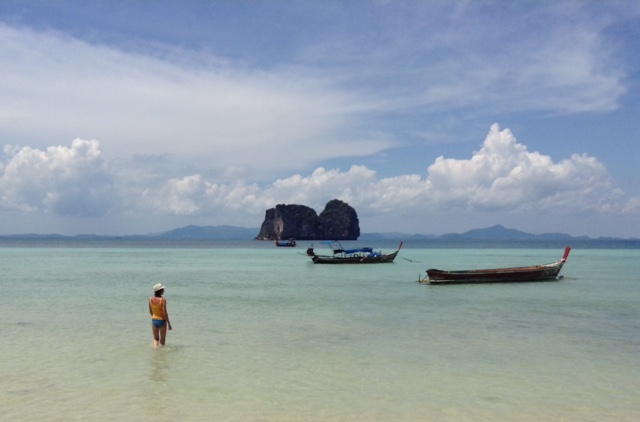
A short boat ride away, clear turquoise waters await. We alternated beach days with markets days.
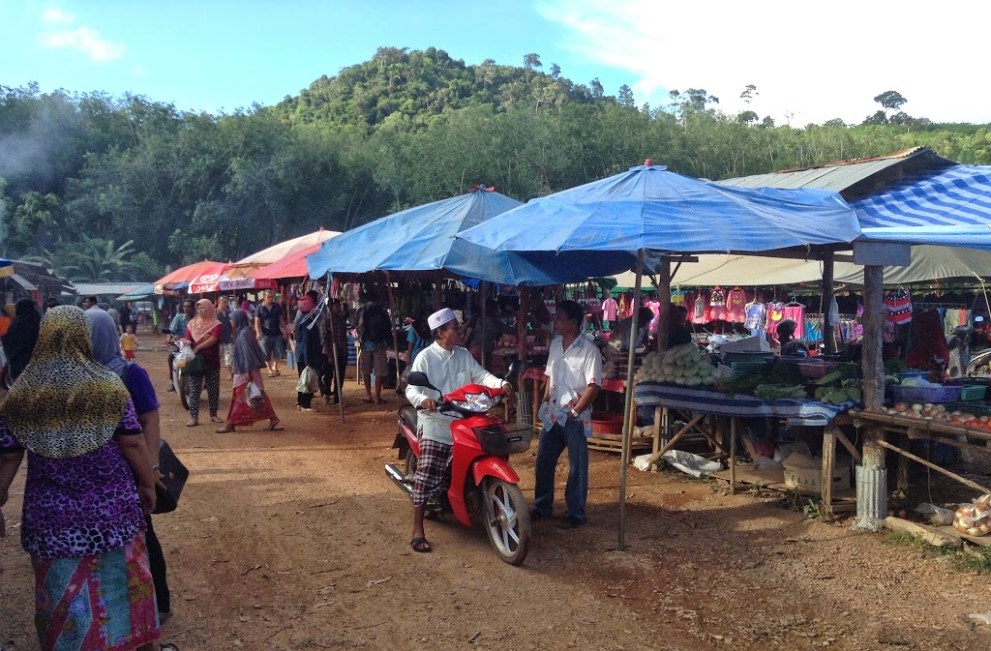
The Muslim market is a small and mobile one. Every day of the week it is in a different location on the island.
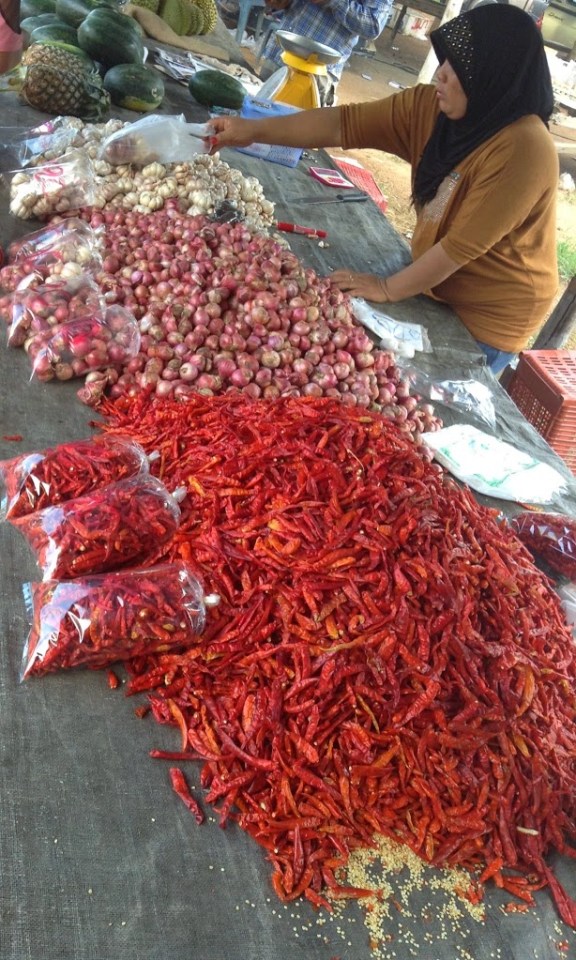
Fire engine red fresh chilies heaped in a pile ~ destined for spicy Thai curry dishes.
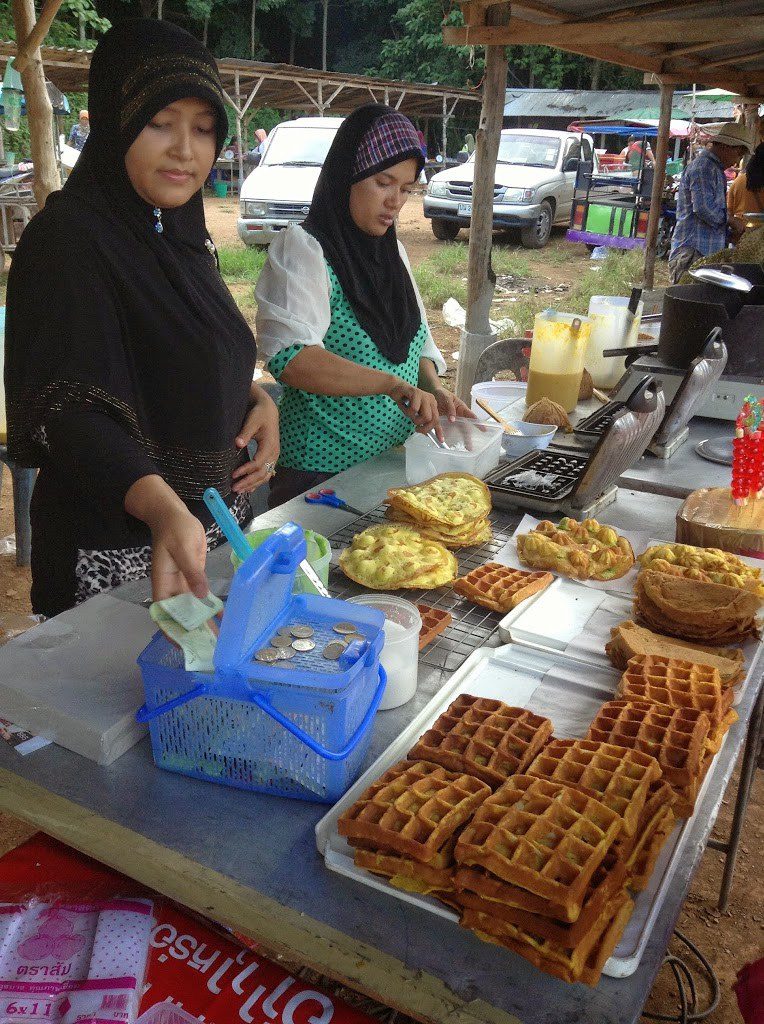
One of the more unusual items at this market which definitely surprised and amused us, was the waffles offering made by these two women. It is neither Thai, nor Muslim food and yet, here it is…
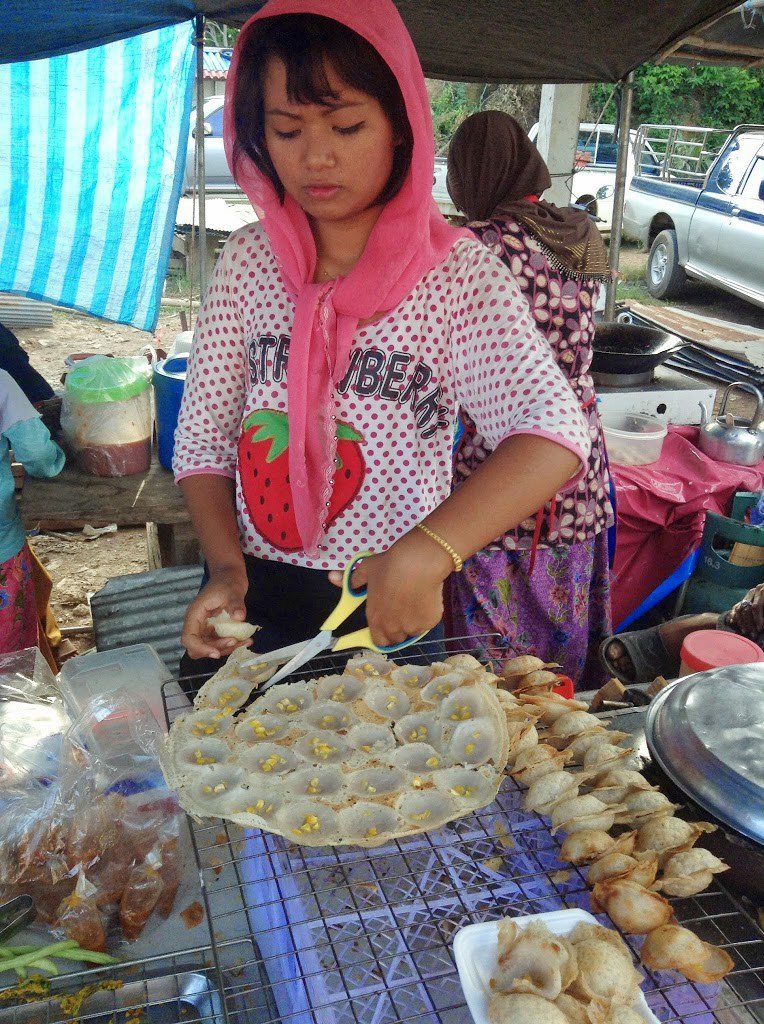
One of our favorite Thai food snacks, found in many different forms.. A crepe like rice flour batter with coconut milk filling. All served up by a modern Muslim girl.
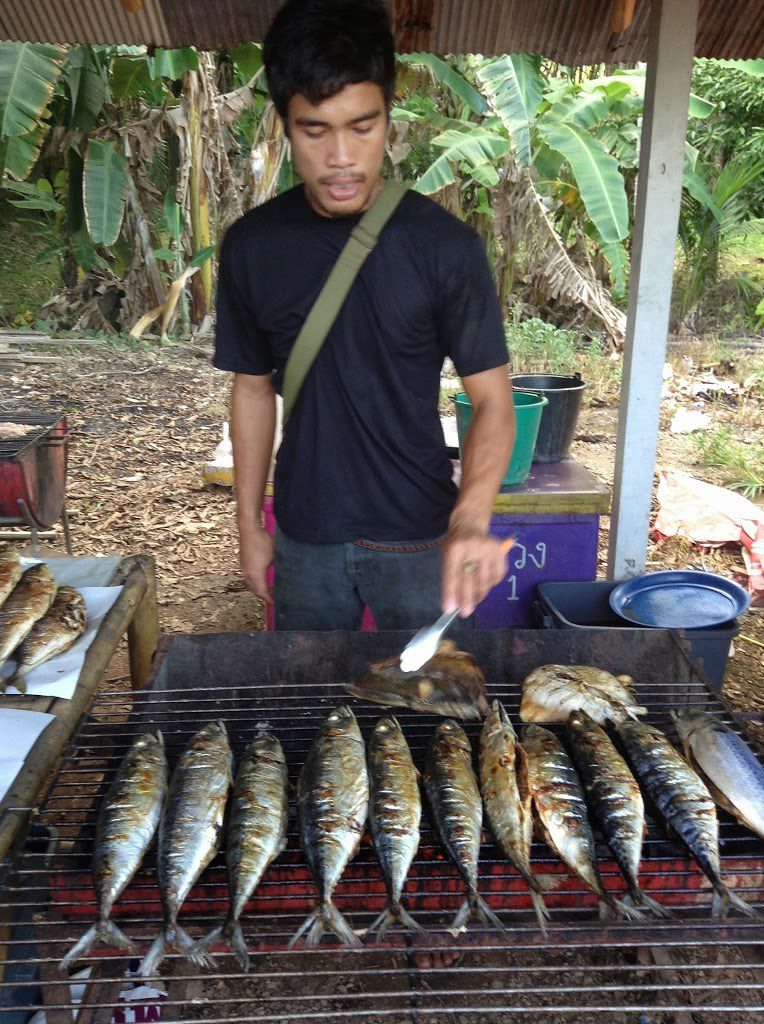
Whole fish grilled on the open flame, is another classic food sold at markets and as well often as street food.

An assortment of colorful produce contrasts quite nicely with the polka dot hijab of the vendor.
Market in Phnom, Penh, Cambodia
We spent a week in Seam Reap and a week in: Phnom Penh, Cambodia where we found a large and fascinating market which spread across multiple city blocks. The most memorable feature of this market: the abundant quantity and variety of dried and smoked fish and tiny seashells.
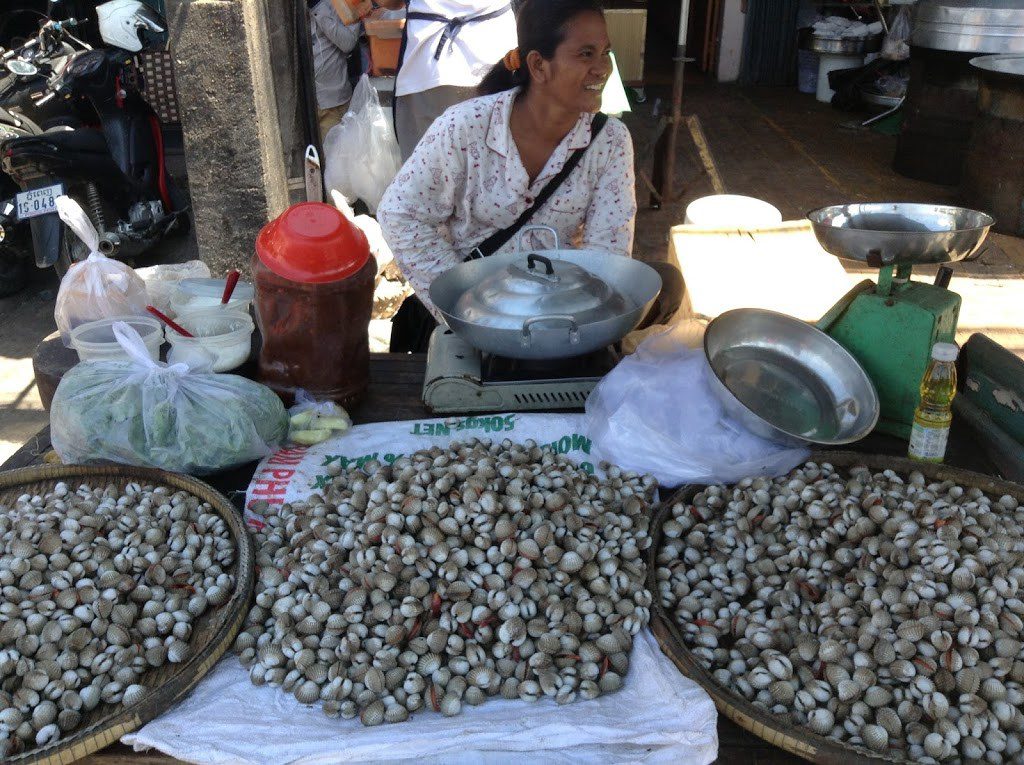
A staple food in Cambodia which we saw over and over again in different formats, was the tiny sea shell. From a distance it is not easy to tell what it is but once you know it, you start to notice it being sold everywhere.
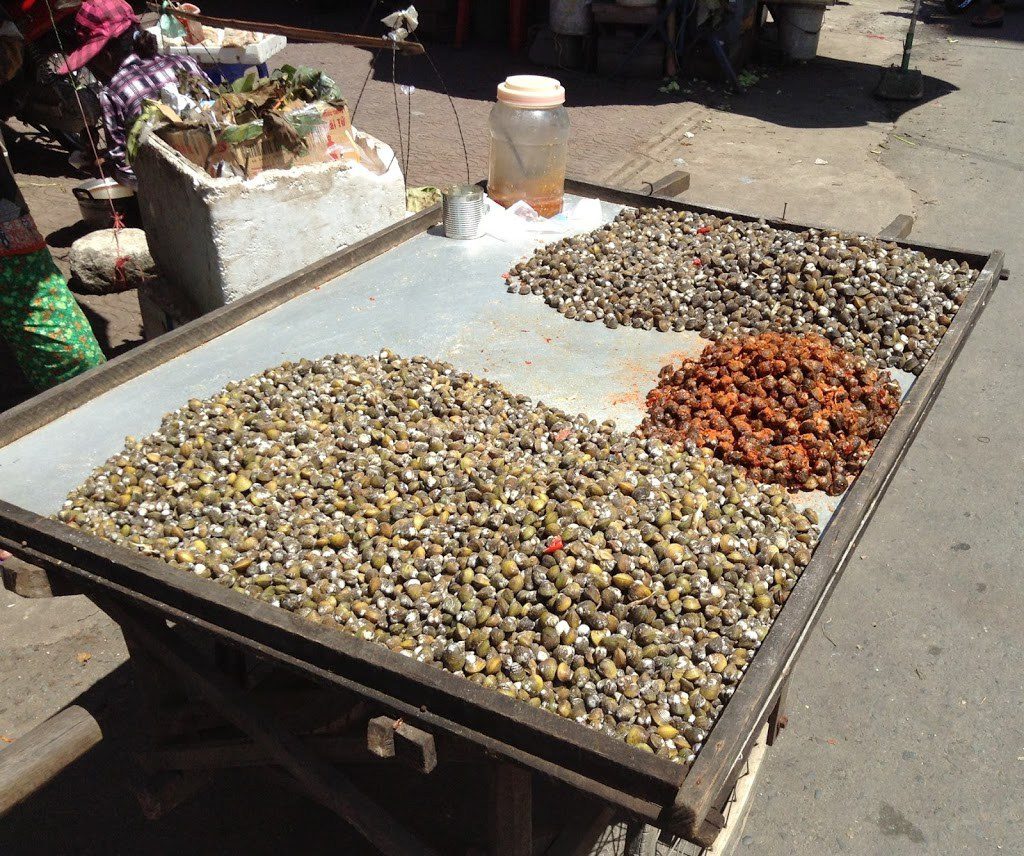
Three different varieties of tiny sea shells being sold from a flat bed wheeled cart. The center ones have been dipped in spices.
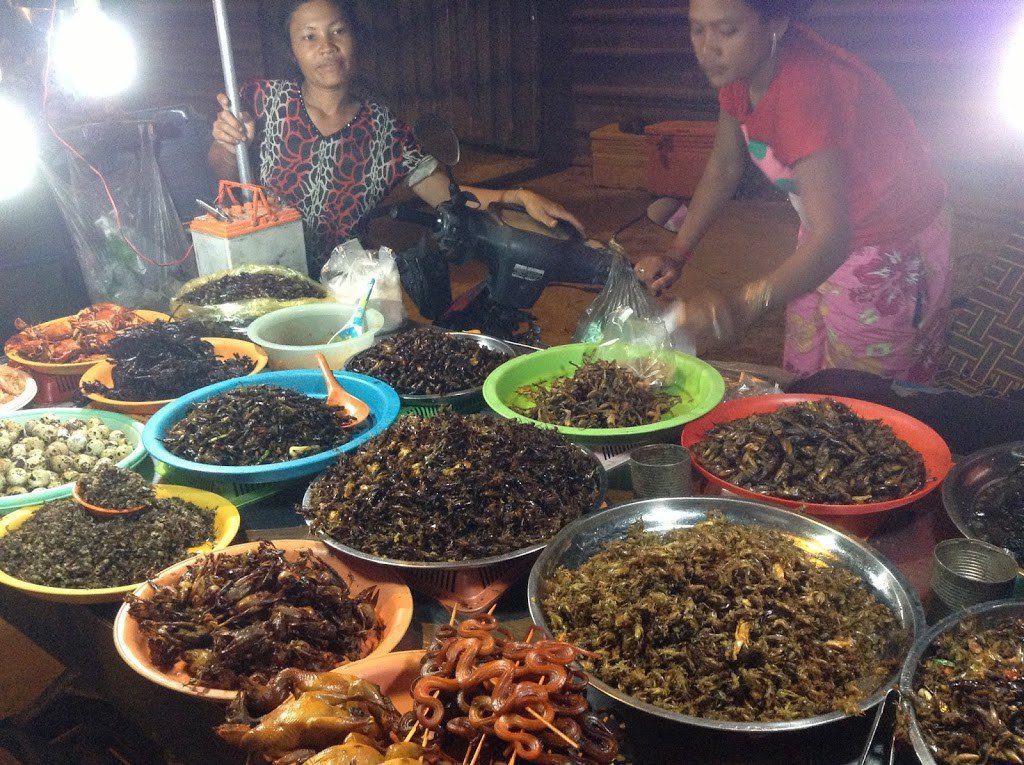
What shopping at the market is complete without a serving or two of crickets, tarantulas or scorpions? We had always heard of “bug eating” but it is still quite a surprise when faced with bowls full of insect “delectables”. And yes, Ben tried the crickets and declared them “crunchy” and an alternative to popcorn?
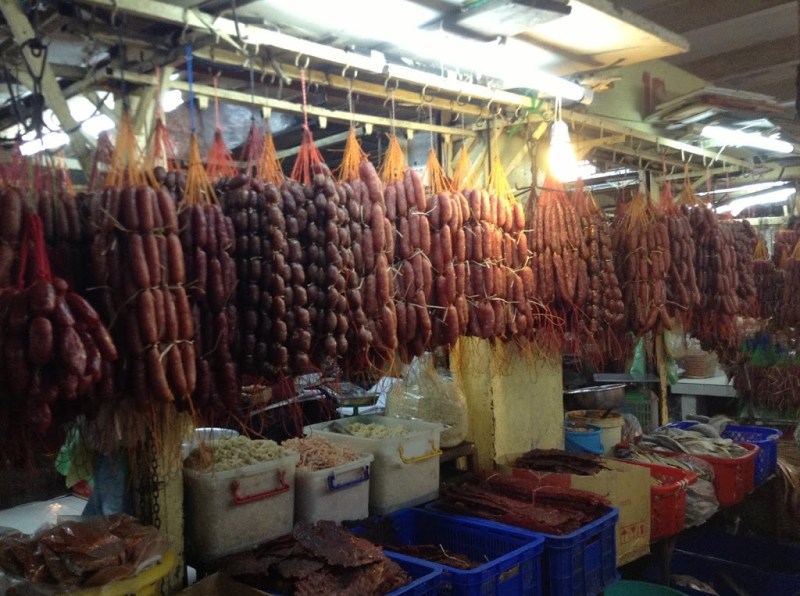
Every shape and size of sausage imaginable.

Bags of dried small red shrimp piled high in the shape of a Buddhist pagoda. Dried fish on the shelves below. A common sight all over Cambodia.

At lunch time this market is packed with locals all eager for the daily specials, and we are no exception. You can see Peta in the front at the counter, inhaling her soup with noodles. It is quite a hectic and boisterous scene, as bowls of steaming hot soup and noodles, are dished up and handed out to hungry patrons.

Layer upon layer of large dried fish in an unusual fan shaped display.

The geometry of dried fish.
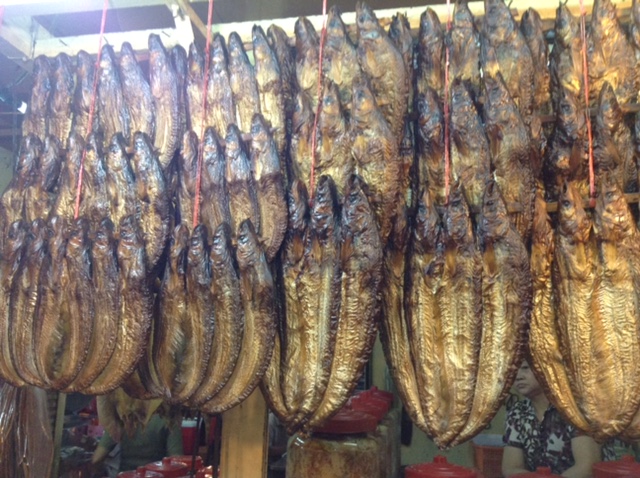
It really IS all about the dried fish! They make quite a dramatic graphic design, all strung in a row.

This vendor was selling his dried, smoked fish by the box. The fish are all neatly cooked and packed in rows on skewers.
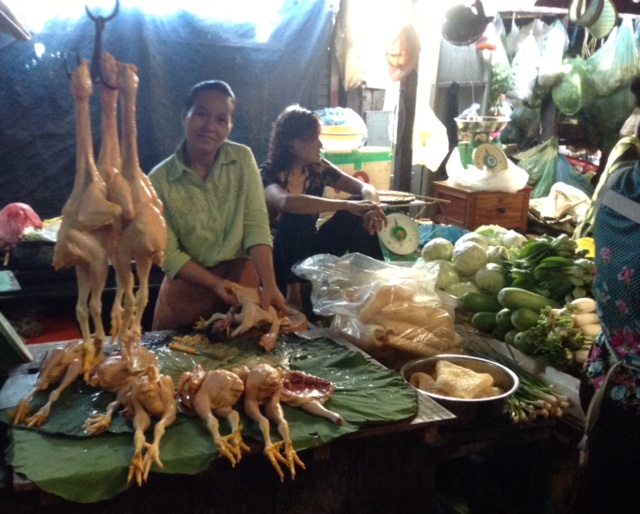
With the insides of the chicken being scooped out the carcasses are then hung from hooks ~ claws, beaks and all, ready to be cooked.

Artisanal coconut ice cream all stacked in a metal cone shaped vat with blocks of ice at the bottom keeping everything frozen. These are a very welcome treat after a hot morning at the market.
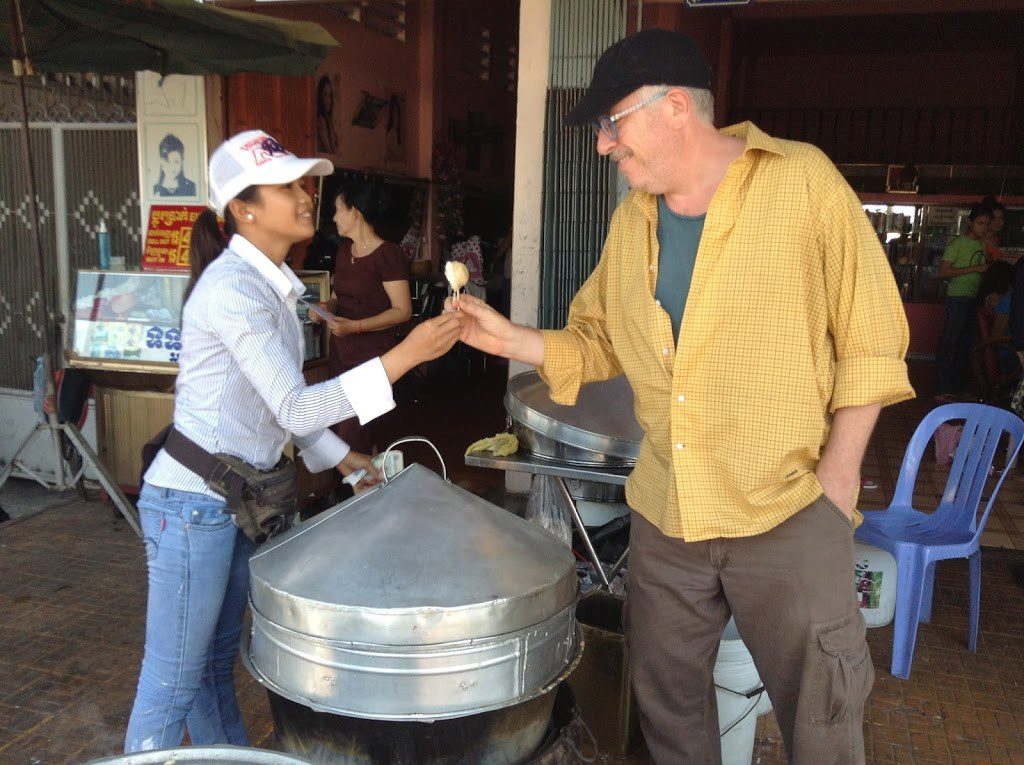
How can he refuse a homemade coconut ice cream from an attractive Cambodian woman?
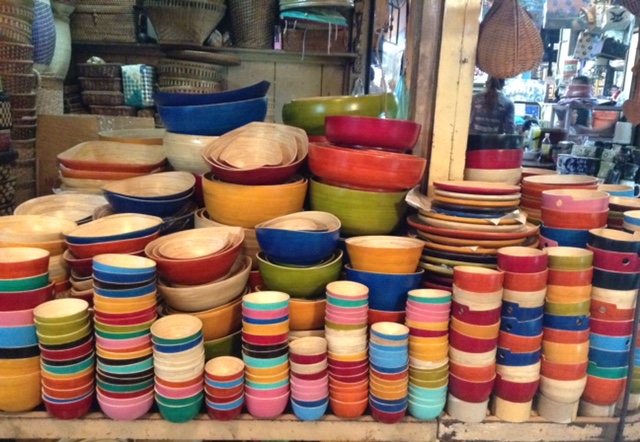
Bamboo bowls in all sizes give quite a splash of color amongst the fruit, vegetables and dried fish! This Cambodian market is not all produce and prepared food, it also has an impressive array of craft.

Antique teapots hang in clusters like oversize grapes on a bunch. Given that we were living out of small backpacks at the time and were nomadic, we had to pass on these beauties.
Market in Bagan, Myanmar
An entirely different market experience awaited us in Bagan, Myanmar. years later….
From the big, crowded and high energy capital city of Phnom Penh’s street market, we take you to the slow flowing rhythms of a tiny market in the ethnically rich and historically important province of Bagan, in Myanmar (formerly known as Burma).
But first, to situate Bagan’s market, consider that it is smack in the middle of the ancient temple rich Bagan valley.
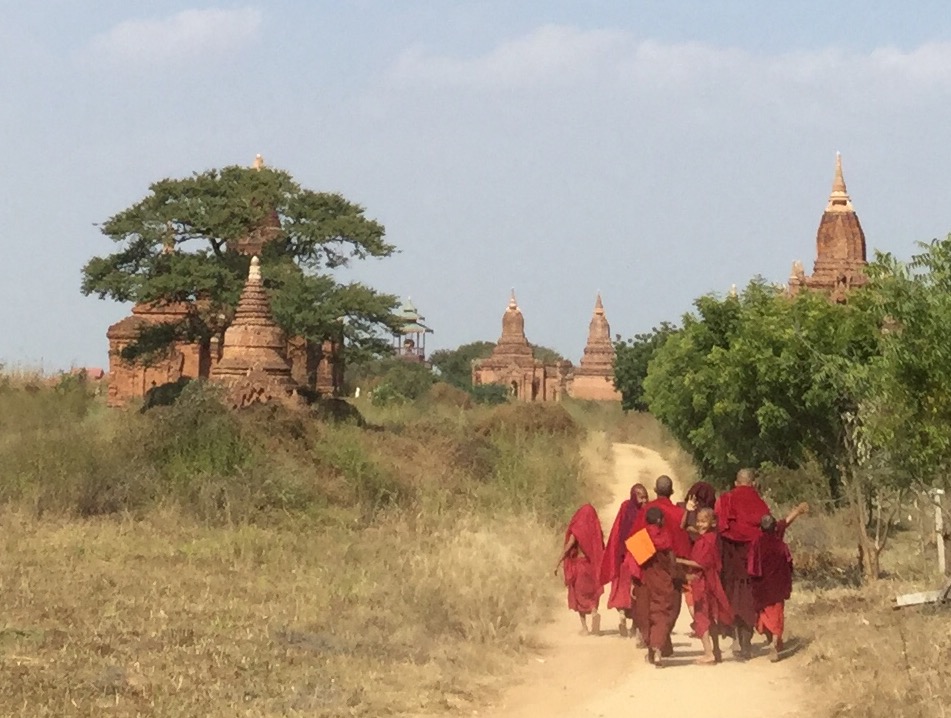
This might be one of my best photographs ever. Capturing this moment of a group of young monks on a brisk morning walk to their monastery, with the ancient structures in the background encapsulates the feeling of being in Bagan, a magic like no other.
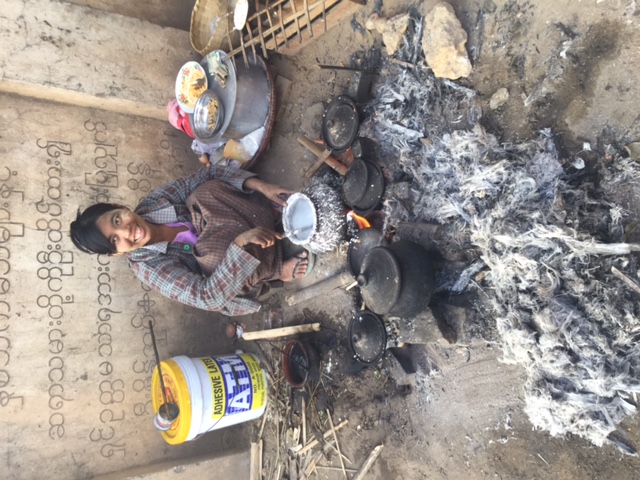 The making of a chickpea flour based pancake ~ cooked over hot ashes. The wall behind, has the beautiful Burmese script. We were pretty happy to come across these piping hot sour dough treats, after having watched the sun rise over the ancient Buddhist temples over the Bagan valley. Walking in no particular direction across the vast plains, we made our way towards the sounds of a village waking up, beyond our horizon once the sun was up and the day was about to begin.
The making of a chickpea flour based pancake ~ cooked over hot ashes. The wall behind, has the beautiful Burmese script. We were pretty happy to come across these piping hot sour dough treats, after having watched the sun rise over the ancient Buddhist temples over the Bagan valley. Walking in no particular direction across the vast plains, we made our way towards the sounds of a village waking up, beyond our horizon once the sun was up and the day was about to begin.
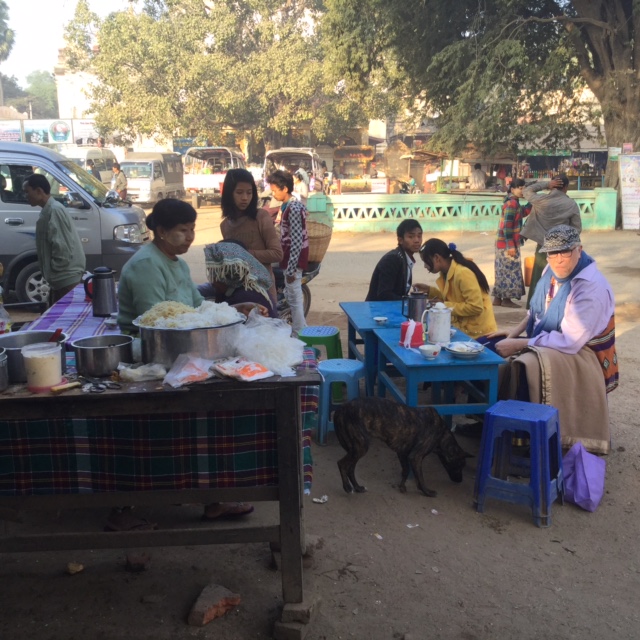
After watching the sun rise, and before going to market, breakfast is in order. Don’t let the rustic setting fool you ~ this made for a very delicious breakfast.
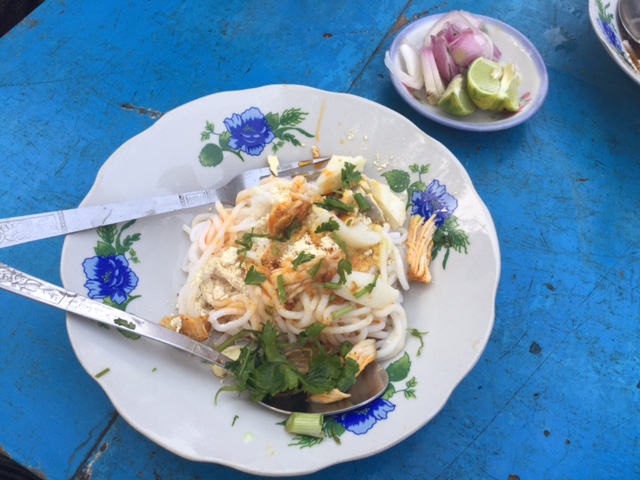
Yup, doesn’t look like much. And yet… we came back for breakfast 3 days in a row. A distinct flavor profile. Spicy, acidic and yet sweet, hard to describe but a perfect balance between the soft noodles and the crunchy top. A memorable culinary experience.
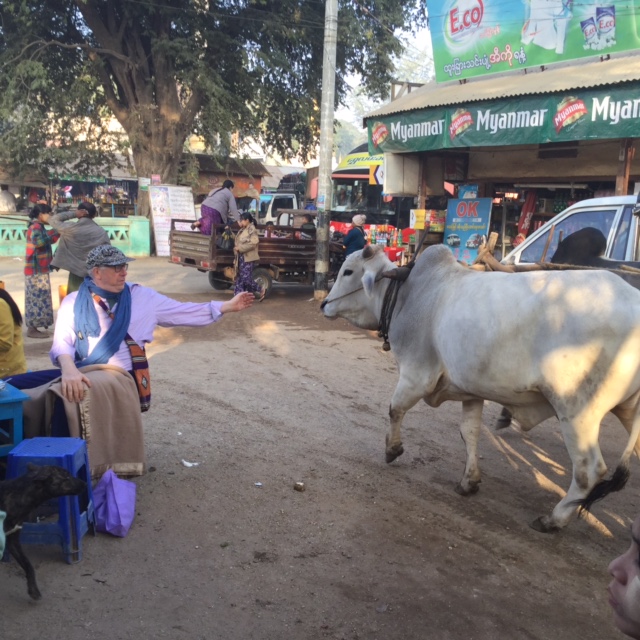
Before we stumbled upon the little market, we had a plate of Burmese noodles being made at a table on the side of the road. We had a visitor pass by while we were eating.
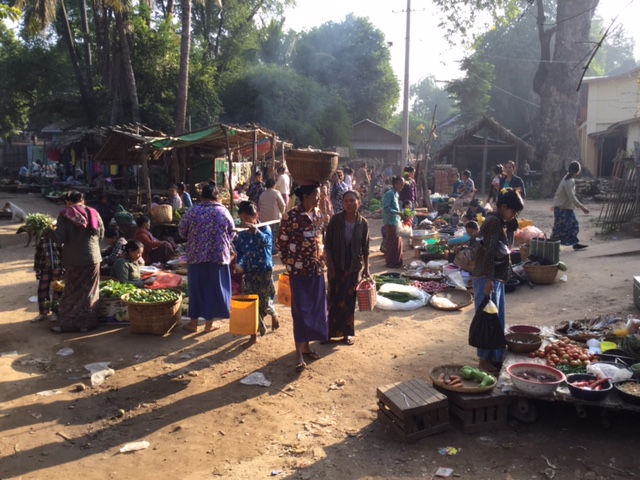
At first glance this seems like a dusty, not particularly interesting market. But markets are definitely in the category of “don’t judge a book by its cover.”

The colors here were what first captured my attention. The vendors green sleeves being the same tone of green as the veggies on the right of her cloth. The peach of her head scarf, reflected in the tomato tones on the left.
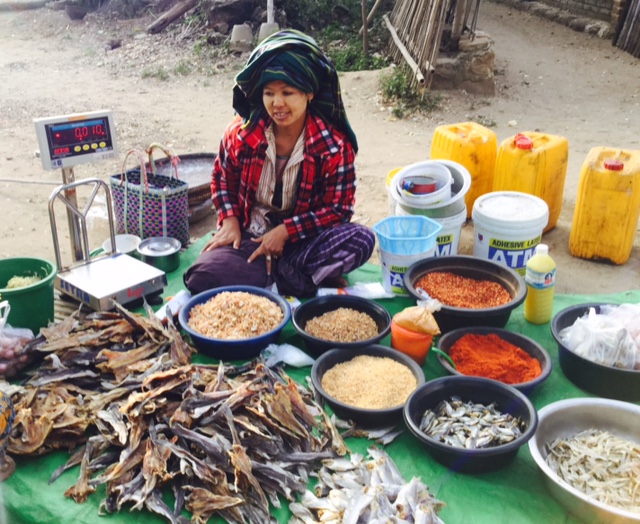
In this region of Myanmar the women wrap their heads in thick cloth ~ Thicker than a scarf, thinner than a blanket. this vendor is selling all types of dried fish and some spices for cooking them.
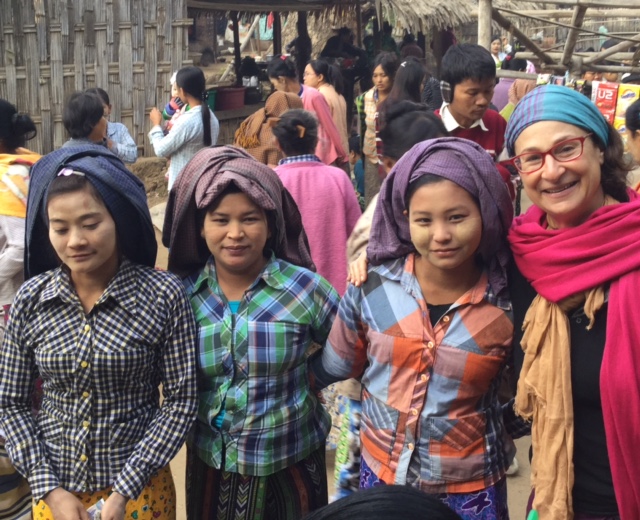
It’s unlikely that these women have seen many foreigners before, if any. So their curiosity level was as high as ours, they were shy but friendly and happy to pose for a photo with me as a moment of brief friendship. Women in Myanmar apply a paste made from tree bark to their faces as a form of sun protection in order to keep their skin as fair as possible.
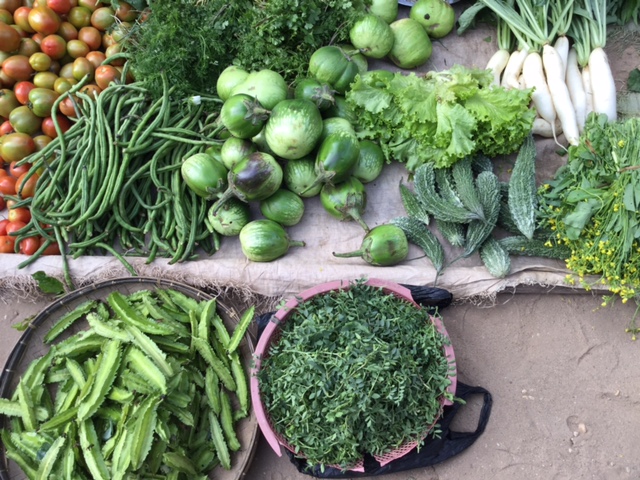
The offerings at each vendor are modest, yet there is plenty variety of greens and interesting looking vegetables.
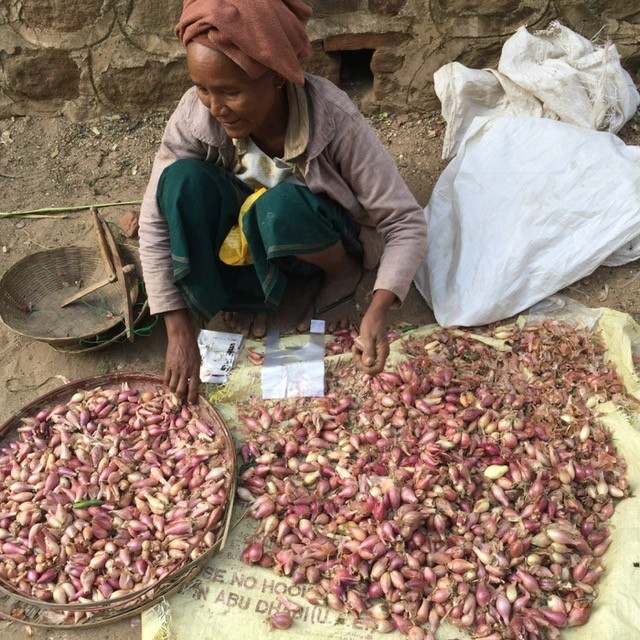
Shades of mauve at this shallot seller.
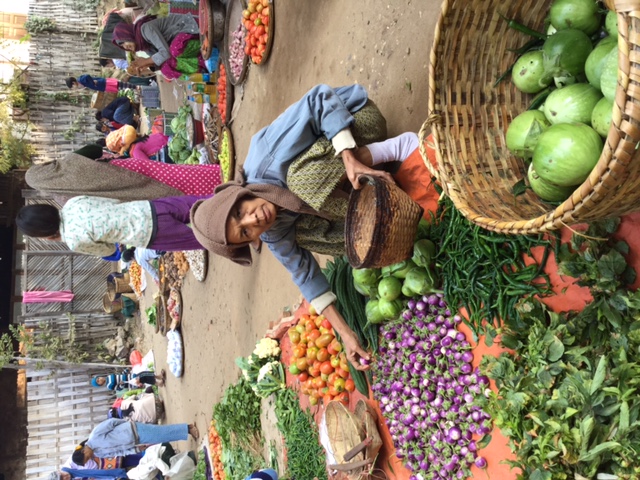
A buyer carefully selects small round eggplant for the meal that will be cooked later at home.
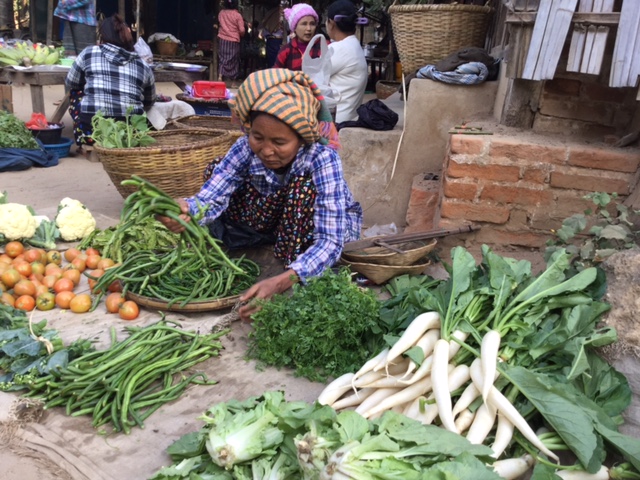
Love the combination of stripes and plaid in contrast with the solid colors of the vegetables.
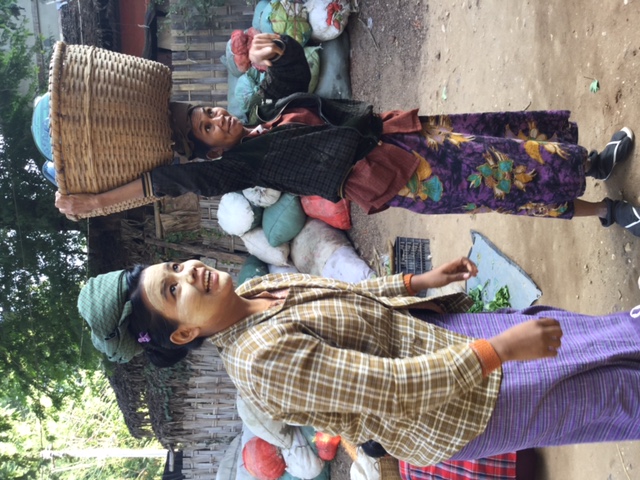
It is quite the balancing act. Women carry all sorts of heavy baskets on top of their heads, much like women in Africa do.
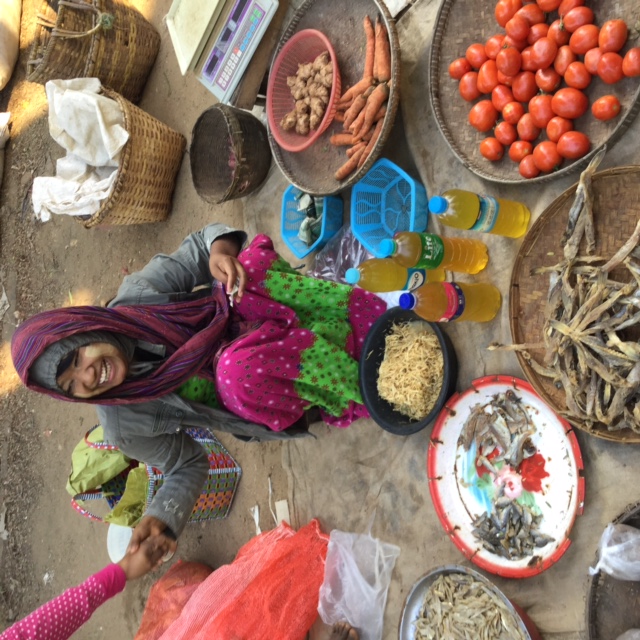
Lots of smiles between vendors and buyers. Most are regular customers who come to the same spot day in and day out. We were definitely the newbies and noticed by everyone with much interest.
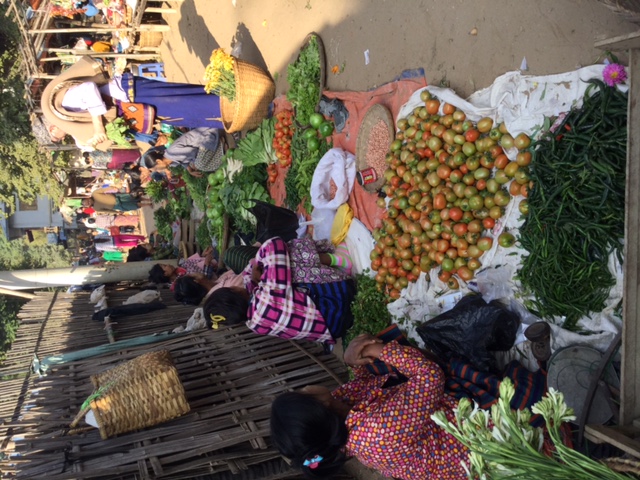
There is Ben, cruising along. We were up before the sun in order to watch it rise over ancient temples, hence the blanket he has on his shoulder. The mornings here are quite chilly before the sun warms things up….The market in a small village is also the place where people socialize and linger enjoying the process of interacting with their neighbors.
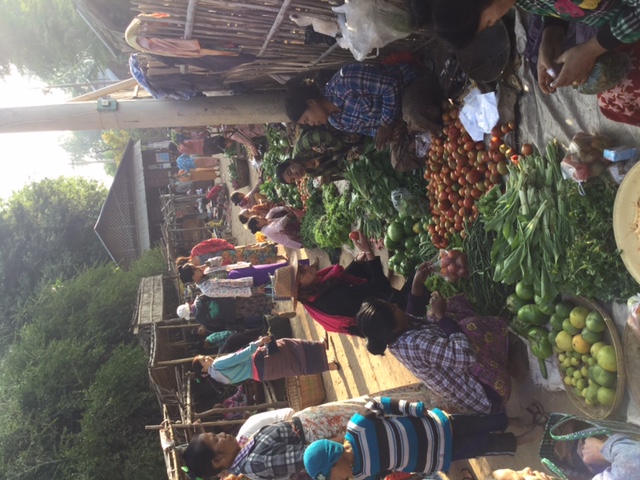
Peta is in her element, right in there with all the locals… she makes a point of selecting a few picnic items to buy, which gives her an easy way to interact with people. And typically, another shopper breaks in to guide her toward the right tomato or the best radish. They too seize the opportunity to have a “normal” market interaction, but with a foreigner.
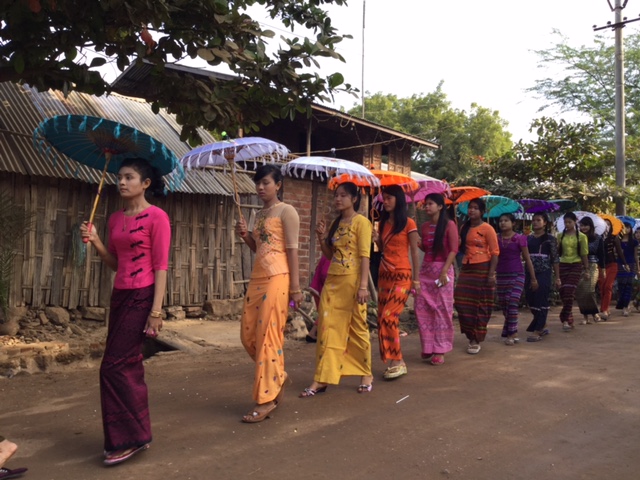 As we make our way from the market, we are fortunate to witness a celebratory procession. Beautifully dressed women with parasols, and children in bright silk outfits, atop large oxen carts decked out for the occasion. Unexpected pageantry in a rural setting. This is the celebration of the entry of young boys. into Monk-hood.
As we make our way from the market, we are fortunate to witness a celebratory procession. Beautifully dressed women with parasols, and children in bright silk outfits, atop large oxen carts decked out for the occasion. Unexpected pageantry in a rural setting. This is the celebration of the entry of young boys. into Monk-hood.
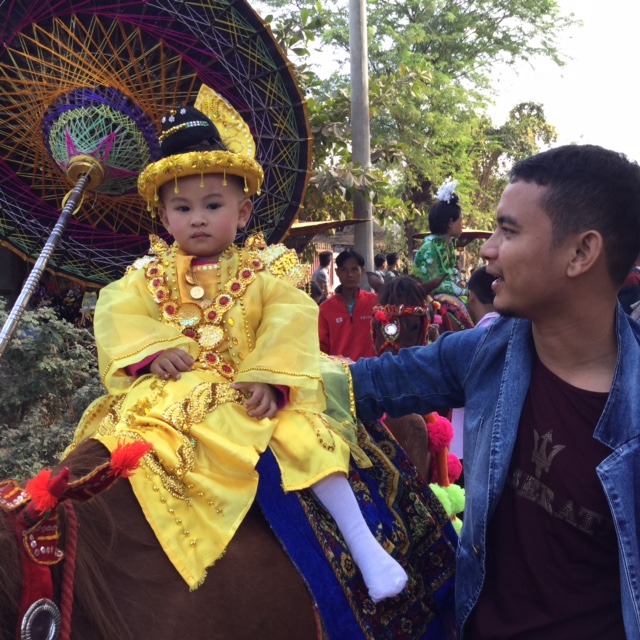
A regal looking young boy, on the most important day of his young life, entering the monk hood. It is a great honor to have one’s son enter the monastery as a novice and for those who choose to remain within the monastery, an opportunity for a quality education awaits.
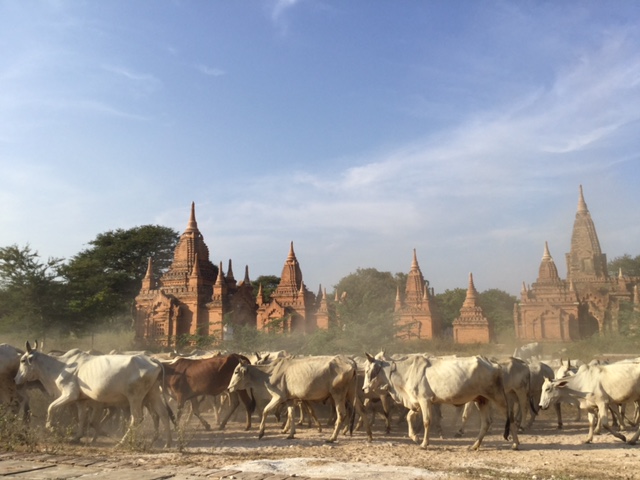
We had the most dramatic backdrop for our picnic from the market. We were quietly sitting in front of a group of ancient temple pagodas, enjoying the immense tranquility of the moment. From over the horizon came the faint sound of what we thought might be drum beats (?), which gradually got louder and louder, until it reached a crescendo of hard hitting hooves on the dusty ground right in front of us! We held our breath in reaction to the dramatic appearance of this herd, moving past, in a cloud of dust. In seconds, they were all gone, and silence returned.
A large market in rural Myanmar
Myanmar is a joy for seasoned and independent travelers as tourism is very much in its infancy (thankfully). We made our way across the countryside, using buses, tuk tuks and even in one instance, a car and driver.
We are not in a hurry and have no particular plan nor schedule and this invites a slow discovery. We enjoy using forms of transport which allow us to stop opportunistically. One such s stop yielded the discovery of a flower market on the way to Yangoon, Myanmar

This particular market has a whole row of flower sellers. Here beautiful peach, ruby red and ivory rose buds are piled up for sale.
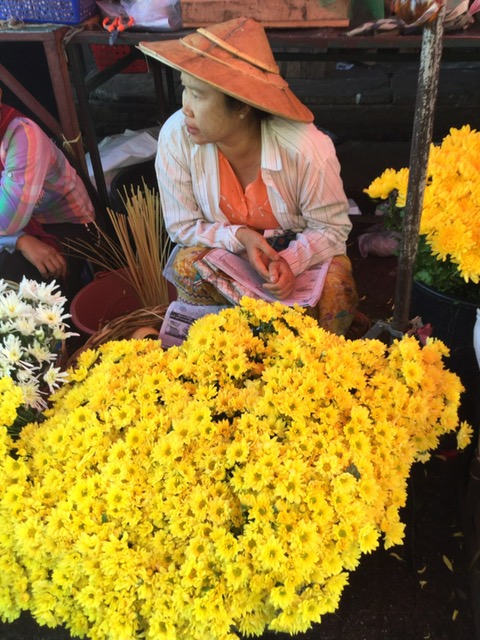
A bright golden glow from these yellow daisies brightens up the dusty alley.

The corn being cooked in its husk is piping hot and the steam creates a curtain of smoke in front of the seller. Her face is painted with a customary paste made from tree bark, which protects the skin from the sun and is applied to the face in the attractive designs (the most common form being a circular patch on each cheek, and highlighting the bridge of the nose.).
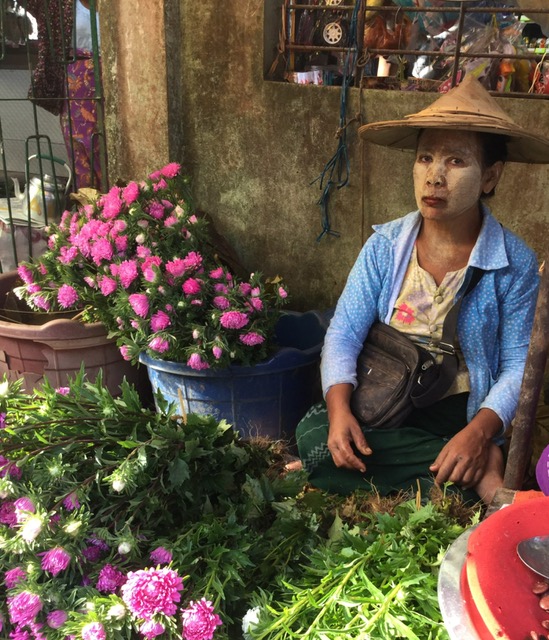
This flower seller has her whole face covered in “thanaka”, which is a distinct feature of the culture of Myanmar. It has been used by Burmese women for over 2,000 years.
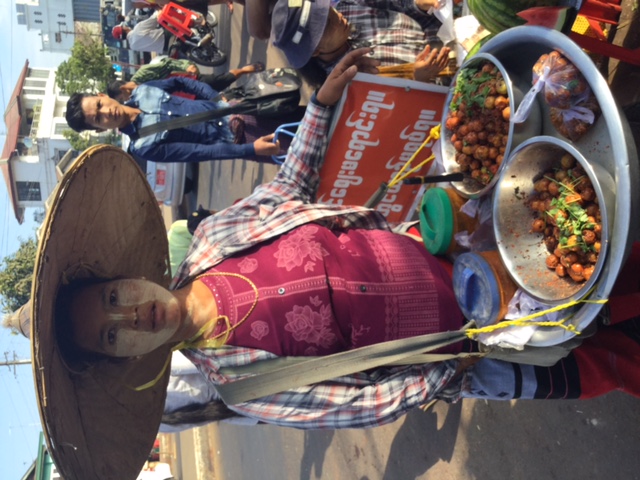
This vendor has a hat as large as her metal tray from which she is selling some spicy fishballs. She is definitely surprised, if not shellshocked to see a foreigner in these parts.

Lots of people market shopping fill the streets and the alleyways. Piles of fruit, in row after row, show that this is a fertile region of Myanmar.

Ben fits in to this market rather nicely with his” longyi”, which is a piece of fabric that men wear wrapped around their waists, in lieu of pants.

Carrying not a basket, but a huge bag of goods on her head. No hands, just perfect balance.
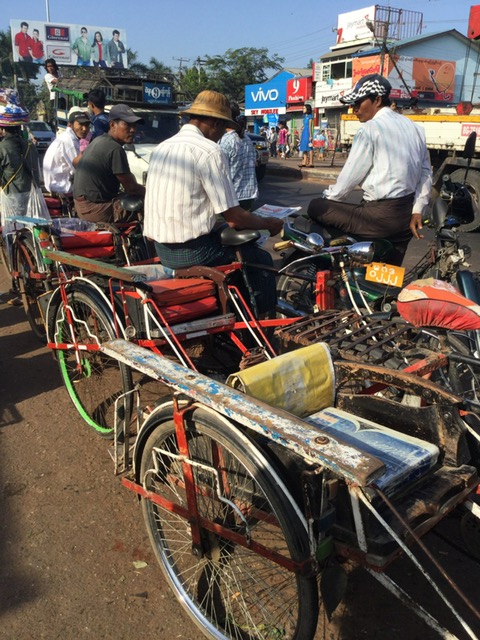
Tuk tuk drivers lined up awaiting the opportunity to offer a ride to shoppers going home after their market purchases.
Good morning!
As usual, I am fascinated by what’s filling up your senses these days. How lucky you are to see such things. Tell me, what does one do with a dried fish? Eat it like jerky? Get it wet and cook it? Is it salted, or just dried in the sun?
Wishing you continued health, safety and fun,
Charles
Charles thanks for stopping by to read us and comment, nice to hear from you again!!
The dried fish is used in dishes like soups and stews as a flavoring agent to provide not only the flavor of the fish but as well a salt component. Definitely not eaten as a jerky, it is way too salty. The salt is used as a preservative for the fish as most people do not have refrigerators. The fish is both salted and dried in the sun and sometimes also smoked.
Thanks for the lovely wishes,
Peta
It’s hard to decide where to focus – on the luscious-looking fruits and vegetables and other products, or on the beautiful people. Two people really stood out as stunners: the polka dot hijabbed young woman and the regal little boy! Gorgeous.
Do people eat the tiny seashells with spices in Cambodia? Or just lick off the spices / suck out what’s inside? I can’t quite figure that one out. Seems like a tooth-breaker!
Finally, I love your philosophy of having “normal” marketplace interactions with those you encounter. I need to push myself to do that. I always worry that I am taking their time away from “real” customers and acquaintances, or that my inability to speak their language will annoy them. I know I am wrong because I do try on occasion; it’s just always a high fence for me to cross. It’s great that it comes so naturally to you.
Lex that is exactly the feeling that we have as we walk the markets…. so much to see, it is hard to know where to look first. That is why we take it slowly through the market at a pace that allows us to take it all in. The regal little boy was just one of many in a long procession, which we were very fortunate to witness.
In Cambodia, the little seashells are steamed, which helps them to open up and then the contents are sucked out. (Definitely teeth are not used in the process.) They are either plain or salted or have spices that were used during the cooking process. Of course there is not much “meat” inside and one needs to eat a huge pile to get full.
Lex, I hear you on the potential awkwardness of interacting in the market with locals… I find this to be very culture specific where some cultures are not “pressed for time”, this is much more of a Western consideration. Time is not so pressured in most of these countries the way it is in the West, and if you consider that relationships and social interactions in the market are a key social function of the market, there is no problem with taking time to chat. Also, because we make a point of buying produce, we too, are “real customers”.
Peta
Mouth-watering photos! Most of them, anyway. The waffles did stand out. I’m quite hungry now and it is time for lunch, thank you very much. 🙂 How does one eat the meat in those tiny sea shells? I’ve tried the crickets before – crunchy and salty, but have never ventured beyond that to cockroaches, spiders or scorpions. I think I do prefer popcorn, despite not liking the salty American version very much. In Belgium, popcorn is always sweet.
Beautiful post and scenes and that photo of the monks and the stupas is, indeed, a winner!!!
Thanks Liesbet! The meat in the tiny sea shells which have been steamed, is literally sucked out, although of course, there is not much “meat” and the shells are eaten mostly as a snack. In Cambodia the practice of eating bugs emerged during the Pol Pot era when there was mass starvation and people ate whatever they could to survive, insects included. Even though the agricultural sector has recovered and the country now produces enough food to feed the population, insects have remained as a food source. Ben wanted to try one of the tarantulas, but I had to stop him as I figured the health risk was not worth the experience!
Ben lived and worked in Northern France for a while and spent some time in Belgium and he too thinks of popcorn as a sweet.
Thanks for the lovely comments and positive feedback on the photography.
Peta
Love the flowers, the beautifully dressed young women, the little boy who looks far too young to be handed over to a monastery, and, of course, your favourite monk picture. The herd thundering past is pretty special too.
Thanks Anabel. In both Myanmar and Laos we met and spoke with many monks and invariably found out that their relationship to the monastery starts at a young age. One other related aspect of how central monkhood is, (for example in Laos), that when a young boy gets accepted into the monastery this is seen as a great honor for the whole family and earns good karma for years to come.
P&B
It’s pretty wonderful to tour these countries with you. I love the artistic displays of food and wares – these folks take pride in what they do, however humble their work may be. Your commentary is always illuminating.
And now, of course, I’m hungry. But not for insects. Too much ick-gag factor for me, even though I do appreciate the protein they provide for people whose diets are not luxurious.
Thanks Shari, glad you are enjoying the “virtual” travel. Good observation about the pride in what people do. Maybe this connects to the fact that everyone is Buddhist and the central tenet of Buddhism of course, is mindfulness. And when one is mindful about what one does, it shows! thanks for the compliment on the commentary.
Yes, as mentioned in a response to an earlier comment, in Cambodia insects became standard fare during periods of starvation and the need to eat anything for survival was core. Now it is more a question of habit.
P&B
Interesting variety. I bet it smells “interesting” in spots too.
Dave, the market place is always full of interesting sights and smells. Actually, the dried fish does not have a very strong smell at all in comparison to fresh fish markets.
Thanks for stopping by to read and comment.
Peta
Oh thank you for this wonderful trip down memory lane! I’m sure I’ve been to some of these exact same markets. I especially loved seeing the ones from Myanmar again. It was one of my favourite places.
Alison
Alison for us too, putting this post together evoked amazing memories of being in Myanmar in particular. We spent a full week in Bagan and could have still stayed longer. It is interesting isn’t it how particular countries have particularly distinct features to their markets.
Peta
I tend to be overwhelmed in big markets, Peta, but I could linger on that beach at Koh Lantu for a day or three 🙂 🙂
Jo, the island beaches in Thailand are of course beautiful, but actually we spent very little time beach hopping in Thailand and more of our time was spent in cities such as Bangkok and Chaing Mai. In particular we spent quite a good amount of time in Chiang Mai, which is in the North and known for its great food!
Peta
You find the most amazing markets. I love the stampede of cattle in front of the pagodas. That is my favourite picture out of all the fabulous shots. The little boy off to become a monk is quite special as well. Markets are just the best way to learn about a place and its people.
Thanks Darlene for such lovely comments! It was hard to select which market photos to feature in this post as we have such a rich collection of them. Of course there are lots of other photos from our time in Myanmar, which are in the archives, in case you are interested to take a peek. I just had to sneak the stampeded of cattle and regal little boy into the market post, to add context and to feature my favorites.
Peta
This could be a gorgeous book on exotic markets.
Each of your photographs is truly remarkable!
I find the different culinary traditions fascinating, including the way that foods are displayed with such care and artistry. Although I have quite an adventurous palate, I don’t think I could get past my feeling of “ick” when it comes to eating bugs. I would try any of the seafood, though!
Love, love, love your photo of the monks. And your opening photo — it’s heavenly. I believe that must be you, Peta, standing so serenely in the water.
Laurel thanks, we have actually considered a self published book. Now we need the time…:)
I too (Peta) would not eat the bugs. I just thought it was “unnecessary” 🙂 and as well they did not look at all appealing to me. As in, I was not even the tiniest bit tempted!
So glad you love that photo of the monks as much as we do. We have so many amazing photos from our travels, that it really is hard to narrow it down and even though this post is about markets, we do like to give the markets some context which gives us a chance to feature some of our best photos once again.
Yes, that is me, standing in the ocean, taking it all in. The colors were so heavenly, just like I imagined they would be. We spent the day on a boat, going snorkeling and visiting different small islands, but this one in the photo was my very favorite. I could easily have stayed there a week.
Thanks for your lovely comments Laurel.
Peta & Ben
I loved the unexpected photo of the waffles in Thailand but I’m not sure I’d be game to try the insect delectables of Cambodia, however spiced or crunchy they might be! Your photos and narrative of Myanmar however, captured my attention and had me vowing to visit this utterly amazing country. I loved the photo of the young monks in their red robes with the temples in the background, the procession of the women so beautifully dressed with the colorful parasols, the cows with yet more temples in the background and the flower market. Exotic, completely foreign and oh, I so want to visit this mysterious country for myself!
So here you go… Viet Nam plus Myanmar, a perfect trip! Thanks for your enthusiastic feedback on this post. Our youngest son met us in Viet Nam and we travelled together on the Ho Chi Minh trail and down to the Mekong Delta. He went to Myanmar by himself and we all met up later in Laos. After his trip to Myanmar he told us that we HAD to go there!!! We got there a year later and are so glad we took his lead. When you think Asia, this is it, authentic and culturally rich.
Peta & Ben
Peta it’s hard to know where to even begin to comment on this eye popping post. I have so enjoyed wandering the various markets with you. I could almost hear the sounds and certainly imagined the smells of what it would be like to be by your side. The colours so vibrant and varied it is like dessert for the eyes. Now some coconut ice cream for me and a long stroll through that produce section.
Thanks Sue, that’s a lovely compliment. We started writing one retrospective post, then it grew to two, and there are still two more to come! Impossible to select just 2 or 3 photos to represent each market. Stay tuned…
Peta
Wow! That’s a fantastic summary of the markets spread across three fascinating countries. Myanmar is on our list! Loved the first picture of the beach (blue skies melting into the sea). Fresh produce is best found in local markets. 🙂 I second that!
Thanks Cheryl. Yes there is a natural grouping around Thailand, Myanmar, Cambodia and Laos. There are many ways to slice this cluster of countries.. one can look at the architecture, the role of Buddhism and minority religions, the history, the transnational ethnic groups with their distinct languages and customs… and of course there are markets. The economics of Thailand versus Cambodia or Myanmar, are so wildly different as are consumer habits, so it was interesting to peruse markets and get a reading of consumers and produce availability in these countries.
Ben
Fun food markets! We visited BKK in Feb. 2017.
Thanks for stopping by to read us and comment Amy.
Peta
Oh, Peta, you guys live such colorful lives.
I’m awestruck every time I visit here and am so glad to get a glimpse of your adventures.
Thanks Stephanae, what a lovely comment! Being that Ben is colorblind, we do strive for as much intense color as possible in our lives…:)
Glad you are enjoying following our adventures… Two more posts upcoming on Asian markets…
Peta
I love all the colors of the markets, along with the descriptions of all the tantalizing foods, but my favorite photo is that of the monks in their red robes against the backdrop of the ancient temples.
As I am reading these posts to Terry, he is busily reviewing some internet sites on Vietnam. It is looking like a trip to Asia may be in our near future. Thanks again for such an informative post Peta.
Ooh I am excited for you both coming to Asia for the first time! The only problem is that afterwards, other parts of the world might seem rather mundane in comparison.
We have so many incredible images of Asia in our files, that it really was very difficult to select so few for these posts. As you plan your trip, you might enjoy looking through our archives of Viet Nam and other Asian countries ~ to whet your appetite even more!
Peta
Your stories draw me in and I feel like I’m there in the markets with you. There are so many wonderful photos, but I’m drawn to Bagan and the cluster of temples in the background.
I’m a shopper and I would find it hard to travel with just small backpacks and not be able to pick up treasures along the way in my travels!!
I know that insects are a high source of protein and I’ve been told they can be quite tasty … but I can’t. I just can’t :/
Thanks Joanne for the complimentary feedback.
We used to pick up treasures when we travelled, but once we became nomadic there was no way to do this. The lighter our bags, the easier our lives.
I hear you on the insects… haha I feel the same way and would not go near those! Interestingly, I read that there are several food industry start ups currently working on bringing insect protein to the mainstream market. Insects contain more protein than meat and it will be labeled as “alternative protein source” (because most people reject the idea of eating insects). Coming to a supermarket near you. The proof will be in the (insect) pudding. 🙂
Peta
Such close up and down to earth tours of the markets in Thailand, Cambodia and Myanmar. As Lex said, it’s hard to decide on where to focus and from your photos and description it sounds like both the food and people are equally attractive. It really is interesting to see waffles being sold and that they come in big, chunky slices. I remember seeing them sold at markets in Malaysia, Singapore and Indonesia and the waffles would be the only kind of Western food there.
It is interesting to note how dried meats and seafood are very popular over there and you find them all around the markets. For one they look easy to store and I’m guessing they last quite a while too. I’ve had my fare share of dried shrimp, fish and sausage and I love eating them so much. Always best served with something plainer like rice or steamed veggies to balance out the saltiness.
Agree with you that Ben fits so well in with the locals…and so do you too, Peta. I could barely spot you eating your soup noodles 😀 It is interesting how you may dress like the locals yet they can tell that you are a foreigner.
Mabel thanks for the interesting comments about the dried meats and seafood. One of the main reasons for drying, salting and smoking fish is of course to preserve, as the majority of people do not have refrigeration. Among these dried, salted and smoked, being Jewish, my ancestral culinary lineage relates easily with smoked fish. East European Jews (my background), have a history of smoking salmon, trout, whitefish and preserving herring. So, this is both exotic and unknown and at the same time very familiar to us too.
Haha on the comments re “fitting in”… we are aware that we stick out as foreigners, of course, no matter what we are wearing. However, we have found that for example when I am wearing my sarong here in Sri Lanka, or my longhi in Myanmar, local men in their sarongs and longhis smile at me and give me the thumbs up! That is such a great start to so many things…It is a form of non verbal communication we feel, that says, we are approachable.
Ben
Another wonderful market post! I’m particularly drawn to your photos and description of Bagan. I agree that your first photo in that section is outstanding and really captures the mood of the place. However I also really like the ladies in the procession and the beautiful boy all decked out for his entry into monk hook. Myanmar in general looks like a place I need to get too! Thanks for taking me on the journey!
Thanks Caroline for all the positive feedback. It is so nice to know that others are enjoying our photographs and descriptions of places that are special to us.
What is fun about Myanmar is that it is on the rugged and undeveloped side of the tourism range, and we would highly recommend for anyone who can, to get there. Bagan is one of those places where one could say after one day “got it”… or, one could spend 7 days or more, as we did and totally adjust to the most languid meditative pace.
Ben & Peta
That is a really beautiful photo of the monks walking towards the monastery.. One to print out and frame.
Thanks Dee! You are right, we should probably do that!
Peta
There are so many fabulous markets in Asia, and you captured them all so well. I loved Myanmar and I especially love your photos of the Bagan market and the flower market. Myanmar and Cambodia are two of my favorite Southeast Asian countries. Wonderful. 🙂
Thanks Cathy for the flattering compliments. In case you couldn’t tell, markets are a favorite destination. We would love to go back to each and every one!
Peta & Ben